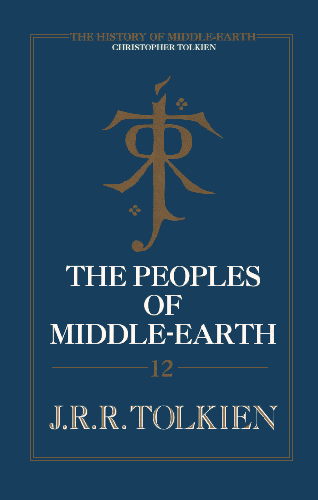Links to Bibliographies
The Big Three
--- Isaac Asimov
--- Arthur C. Clarke
--- Robert A. Heinlein
J.R.R. Tolkien
--- Introduction
--- Bibliography
Science Fiction and Fantasy Series
SF Universes and Fantasy Worlds
| Back to previous page | Record Number: 21740 | |||||

Edited by Christopher Tolkien First Edition 1996 HarperCollins London ISBN 0261103377 Hardback in dust jacket Jacket design by Marilyn Carvell xiv, 482 pages Price: £25.00 Notes Volume 12 of the The History of Middle-earth series. Published on 2 September 1996. A manuscript page, various family trees and a calendar originally drawn by J.R.R. Tolkien and re-drawn for publication by Christopher Tolkien appear as a frontispiece and on pages 89-92, 95-97, 100-101, 104-105, 109-111, 114-116, 134, 221 and 277. Details of all British editions of The Peoples of Middle-earth can be found at TolkienBooks.net.
Blurb – Dust Jacket Flap It was in the Appendices to The Lord of the Rings that there emerged a comprehensive historical structure and chronology of the Second and Third Ages, embracing all the diverse strands that came together in the War of the Ring. The difficulty bordering on despair that he found in providing these Appendices, leading to delay in the publication of The Return of the King, is well known; but in The Peoples of Middle-earth Christopher Tolkien shows that the work had in fact been achieved years before, in essays and records differing greatly from the published forms. In these early texts is seen the evolution of the chronology of the later Ages, the Calendars, the Hobbit genealogies (with those of families that were printed but not published), and the Westron language or Common Speech (from which many words and names are recorded that were afterwards lost). Following the account of the Appendices a number of other writings by J.R.R. Tolkien are included in this book, chiefly deriving from his last years, when new insights and new constructions still freely arose as he pondered the history that he had created. This final volume of The History of Middle-earth concludes with two soon-abandoned stories, both unique in the setting of time or place: The New Shadow in Gondor of the Fourth Age, and the tale of Tal-Elmar, in which the coming of the dreaded Númenorean ships is seen through the eyes of men of Middle-earth in the Dark Years. |
||||||
|
| ||||||
|
||||||



